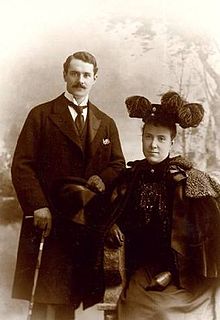Edith Rockefeller McCormick
| Edith Rockefeller McCormick | |
|---|---|

Harold McCormick and Edith Rockefeller, 1895
|
|
| Born |
Edith Rockefeller August 31, 1872 |
| Died | August 25, 1932 (aged 59) |
| Resting place | Graceland Cemetery |
| Spouse(s) |
Harold Fowler McCormick (m. 1895—1921; divorced) |
| Children |
|
| Parent(s) |
John Davison Rockefeller Laura Celestia Spelman |
| Relatives | See Rockefeller family |
Edith Rockefeller McCormick (August 31, 1872 – August 25, 1932) was an American socialite and opera patron.
She was born on August 31, 1872, the fourth daughter of Standard Oil co-founder John Davison Rockefeller and schoolteacher Laura Celestia "Cettie" Spelman (1839–1915). Her brother was John Davison Rockefeller Jr. (1874–1960). Her three elder sisters were Elizabeth (Bessie) (1866–1906), Alice (1869–1870), and Alta (1871–1962).
Edith and her father had an often stormy relationship, where her extravagance would often conflict with his frugality.
She married Harold Fowler McCormick, a son of Chicago's mechanical reaper inventor Cyrus Hall McCormick and Nancy Fowler, in 1895. The married couple spent their first two years living in Council Bluffs, Iowa. They later moved to Chicago. Her country estate, located directly on Lake Michigan in Lake Forest, Illinois and named Villa Turicum, was designed by Charles A. Platt and had extensive architecturally landscaped gardens.
A famous story about McCormick involves an evening in 1901 during a party. News arrived that Edith and Harold's elder son, John Rockefeller McCormick, had died of scarlet fever. It was rumored that when this was whispered to her at the dinner table, she proceeded to merely nod her head and allowed the party to continue without incident. A biographer of her father, however, makes it clear that this could not have been true: at the time of her son's death, Edith was with him at the family estate, Kykuit, at Pocantico Hills, New York. A year later, she and her husband established the John McCormick Institution of Infectious Diseases in Chicago, a source of funding for the researchers who later isolated the bacterium responsible for the disease.
...
Wikipedia
